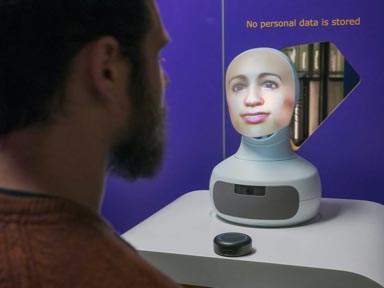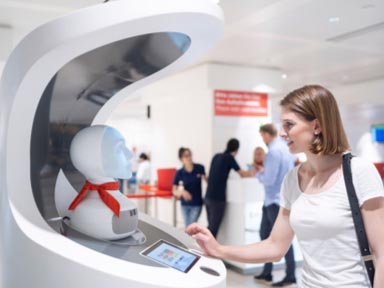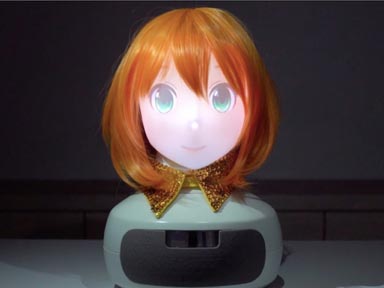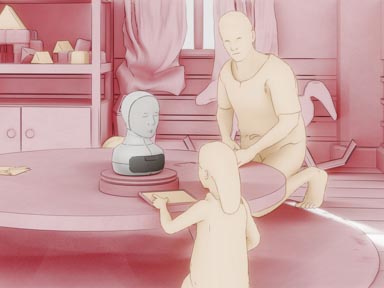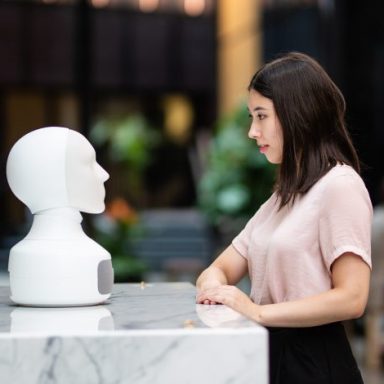How do we define a social robot? What should it look like and be able to do? How does a social robot interact with people? Where do they belong in society and how do they help us?
To help us answer these questions, let’s look back in history a little because dreams and stories of robots have been around for centuries. Already in 1495, Leonardo Da Vinci designed the Robotic Knight aimed for the battlefield and since the late 1860’s robots have started to appear in literature and movies. Many people have grown up watching the adventures of R2D2 and C-3PO in Star Wars, Rosie the robot in The Jetsons, or more recently Ava in Ex Machina. These robots are often portrayed with unrealistic capabilities and “intelligence” compared to where technology is today, sometimes causing unnecessary worry among the general public. Having said that, you have very likely already come across conversational AI such as Siri or Alexa, that already help you in your day to day life. We predict that social robots will take a much different role in society and in our lives than what is experienced with these existing forms of technology today.
Social robots are the next major user interface, that are typically designed based on the oldest user interface we as humans know - the face.
It is hard-coded in our brains to recognize faces, it is something we’re born with and we grow old with. This is the reason why social robots are physical machines – they are built to interact with us humans as we do with each other and involve social behaviours such as listening, speaking and expressing emotions. Social robots build upon the advancements within both physical robotics, speech technology and human behaviour over the last hundred years. These factors set social robots apart from both chatbot and avatars, who can claim to be social but do not take physical form, and also from manufacturing robots, who are often physical but do not exhibit any social skills.
Based on this definition, there are numerous different social robots out on the market. Some products aim to be extremely human-like, such as the robot Sophia made by Hanson Robotics, and others choose a design which is loosely based on the human form, such as the Milo robot by RoboKind. One can also differentiate between social robots that are built for specific and narrow purposes, such as the robot Moxie built to enhance childrens’ development, or robots that are more agnostic platforms that can be tailored to many different use cases.
Although the industry is still early stage, with some brave attempts and major fails, there is no hesitation that social robots are here to stay!
In 2019, World Economic Forum named social robotics one of the 10 top emerging technologies that has the potential to alter established ways of living and provide major benefits to societies and economies. Research & Markets estimate that the social robotics market will grow to 699 million USD by 2023, with the Healthcare sector as a major driver.
Meet Furhat

At Furhat Robotics, we strongly believe that social robots are the next big user interface in society, similar to how the personal computer and smartphones have revolutionized the way we live and interact. When we started to build Furhat, we had two important guidelines; firstly, we wanted to build a robot that was as intuitive to interact with as interacting with another human. Several forms of technology require existing knowledge and skills to be used, which creates barriers for some groups, such as the elderly, the young or illiterates. And secondly, we wanted this to be a robot who could impersonate many different characters, to increase the usability and distinguish itself from other “fixed personality” robots.
The result is Furhat: the first robot on the market with a back-projected face! What’s so special about back-projection, we hear you say? Well, the secret sauce of back-projection is that you’re just a mouse click away from changing skin colour, placement of eyebrows, the amount of makeup, male or female characteristics, size of eyes or lips etc. Animated projection allows for smoother facial movements as opposed to mechatronic designs, meaning Furhat falls short of the Uncanny Valley effect that most people feel when seeing a robot that appears almost lifelike, but fails to mimic a realistic human. Add to this the ability for the robot to participate in a conversation through natural movements such as nodding, head-shaking and raising eyebrows and you are getting closer to a human-like conversation. Coupled with an advanced conversational system, cutting edge speech recognition and automatic lip sync with 40+ languages, the opportunities to create life-like, expressive characters at an affordable speed and cost are limitless!
The customizability of Furhat also means that the use cases are endless - and this is part of the plan.
Instead of only enabling one application, we are building a platform where many different applications and use cases can exist. One can think of it a bit like the iPhone, where Apple builds the physical phone, the iOS and different developer tools, but companies like AirBnb and Uber build the apps. We are doing the same thing with Furhat, but instead of phones, we’re focusing on social robots. Examples of applications range from medical screening robots that can detect signs of deadly diseases, unbiased recruiter robots that completely transforms the interview process for candidates to beloved Japanese manga characters being brought to life in the physical world:
As robot enthusiasts, we also have numerous ideas and visions around what robots can do for society! How about robots that enable COVID-safe sightseeing adventures for tourists, improve the shopping experience in physical retail stores, help off-load overworked medical staff or assist children in practicing social skills? Below are just a few examples of how robots can help humans and companies thrive:
Revisiting the initial question – what are social robots and how will they affect our society? Hopefully at this point, you feel comfortable knowing that social robots are physical robots with the purpose of being used in social contexts, as compared to your smartphone assistant or automatic lawn mower. We also hope that we have sparked a few thoughts on what social robots can contribute to society. But in fact, it’s up to us humans to decide how to harvest the full value of social robots in our business and lives. We have the freedom, and the responsibility, to use social robots in an ethical and value-adding manner, in order to pave the way for a future that at least we at Furhat Robotics are dreaming about!
Are you curious to meet your first Furhat robot? We wish we could meet you physically, but in the meantime make sure to claim a spot on our open demo sessions to see Furhat in action and grab the opportunity to ask our team any questions.
Meet us online
Our online sessions offer something for everyone. Dive in and learn more about the Furhat platform.


